

How to Create a Learning Environment Where All Kids Feel Valued. At a bare minimum, my job as a teacher is to create a learning environment where all kids feel valued, safe, and eager to learn from everyone in the room.

Often, though, as teachers, we get too distracted with getting through curriculum or testing to give enough attention to our classroom culture. But the importance of ensuring that all students feel they can be themselves at school cannot be underestimated. Every day, our students are inundated with messages that magnify and expose the levels of hatred and injustice in our society. For marginalized students in particular, these dehumanizing behaviors make them feel “othered” or like outcasts. A good teacher makes an authentic connection with every student who walks through the door and makes them feel they belong. Never underestimate the power of a kind morning greeting! #OKAware #oklaed #swiftschools…
Icebreakers that Rock. Tolerance. How Teachers Build Great Relationships With Students. The best teachers are capable of maximizing the learning potential of each student in their class.
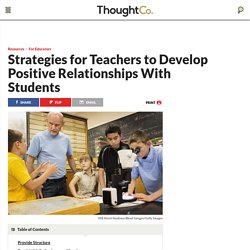
They understand that the key to unlocking student potential is by developing positive, respectful relationships with their students beginning on the first day of the school year. Building a trusting relationship with your students can be both challenging and time-consuming. Great teachers become masters at it in time. They will tell you that developing solid relationships with your students is paramount in fostering academic success.
It is essential that you earn your students’ trust early on in the year. Provide Structure Most kids respond positively to having structure in their classroom. Teach With Enthusiasm and Passion Students will respond positively when a teacher is enthusiastic and passionate about the content she is teaching. Simple Relationship-Building Strategies. Time. 32 Tips For Building Better Relationships With Students - 10 Ways to Build Relationships With Students This Year. On the first day of school I always tell my class of third graders that we’re like a family — a school family.
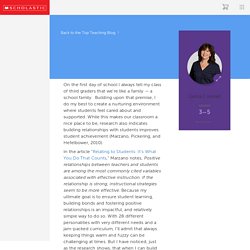
Building a Belonging Classroom. It was Dr.
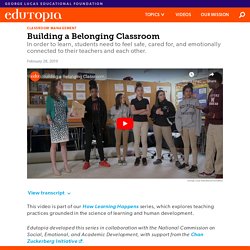
Anthony Fauci who pushed back, in the early days of the pandemic, on the understandable desire for timelines: “You don’t make the timeline, the virus makes the timeline,” he noted tersely, in response to a reporter's question. The implications of that simple statement have become clearer as the crisis drags on, with no definitive end in sight. But if there are still plenty of unknowns, there’s also a pattern of forward momentum as countries around the world—and more to the point, various communities within those countries—begin to open the doors to their businesses, schools, and other institutions. One dictum has given way to the next: Just a few days ago, Fauci appeared to endorse school openings in the U.S. in the fall, particularly as the viral activity in some areas decreases.
“In some situations there will be no problem for children to go back to school,” said Fauci. The Power of Relationships in Schools. Cultivating Trust With One-on-One Time. Making Connections With Greetings at the Door. Knowing Every Child Through Index Card Rosters. How Learning Happens. How can schools better align their practices with what the science says about human learning?

Our new video series, featuring Linda Darling-Hammond, president and CEO of Learning Policy Institute, and Pamela Cantor, MD, founder and senior science advisor of Turnaround for Children, pairs research insights with a variety of illustrative strategies from schools, all grounded in the science of human learning and development. We think these techniques will resonate with educators everywhere: They are focused on taking advantage of the incredible opportunity to help children reach their full potential by creating positive relationships, experiences, and environments in which every student can thrive. In fact, the science is beginning to hint at even more dramatic outcomes. 6 Signs Your Students Like You. Likability is a common trait among the happiest, most effective teachers.
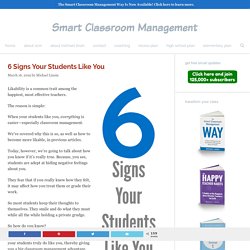
The reason is simple: When your students like you, everything is easier—especially classroom management. Three Little Words That Show Students You Care. Your smile and consistency.
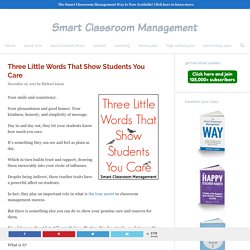
Your pleasantness and good humor. ONE COMMENT. The Power of Being Seen. Teachers scanned the lists attentively, periodically cross-referencing information with colleagues. “Delaney is allergic to red food dye” says one teacher. “And she also has a pond she swims in,” adds another teacher, smiling. While it was only a month and a half into the new school year, some kids had check marks next to all categories—but others seemed more loosely tethered to the school, recognizable only by name and face, their lives outside school a mystery.
“This practice is the foundation of our middle school,” Duvall told the teachers, reminding them of research showing that students who don’t form meaningful connections at school may be at risk for behavior problems, dropping out, and even committing suicide. “Every student needs to belong and connect to at least one teacher or one adult in this building every day.” A District Approach Into the Classroom Horne, for example, has taken steps to close the distance with her high achiever since the library session. New study suggests that greeting students with a positive message yields benefits. Welcoming Students With a Smile. A widely cited 2007 study claimed that teachers greeting students at the classroom door led to a 27 percentage point increase in academic engagement.
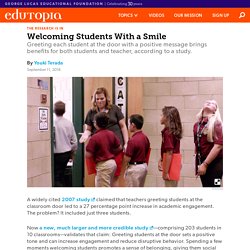
The problem? It included just three students. Now a new, much larger and more credible study—comprising 203 students in 10 classrooms—validates that claim: Greeting students at the door sets a positive tone and can increase engagement and reduce disruptive behavior. Spending a few moments welcoming students promotes a sense of belonging, giving them social and emotional support that helps them feel invested in their learning. The first few minutes of class are often the most chaotic, as students transition from busy areas such as the hallway or playground. Ten middle school teachers were randomly assigned by the researchers to one of two groups. Teachers in the second group attended classroom management training sessions offered by their schools, but they weren’t given any specific instructions on how to start class. Building Community. What’s Missing in This Year’s Campaign Debates About Education.
As a political junkie who works with and studies schools, I pay attention to what politicians say should be done to improve education.
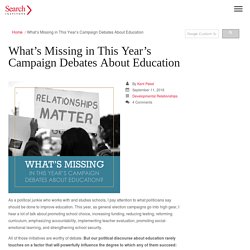
This year, as general election campaigns go into high gear, I hear a lot of talk about promoting school choice, increasing funding, reducing testing, reforming curriculum, emphasizing accountability, implementing teacher evaluation, promoting social-emotional learning, and strengthening school security.
All of those initiatives are worthy of debate. But our political discourse about education rarely touches on a factor that will powerfully influence the degree to which any of them succeed: relationships. The quality of the connections that students form at school might seem too fluffy to merit discussion on the campaign trail, but it belongs there. A Simple but Powerful Class Opening Activity.
At the start of a recent class, my students gathered a bouquet of good news: a trip to Ireland, an end to recent car troubles, an upcoming visit with a friend.
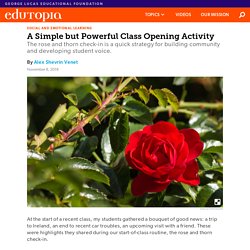
These were highlights they shared during our start-of-class routine, the rose and thorn check-in. In this quick activity, students participate by sharing roses—something positive going on for a student that day—and thorns, which are negative, or at least less than positive. Students can choose their level of vulnerability: A rose can simply be “the weather is nice today.” A low-stakes thorn might be “I feel tired.” Yet many students choose to share more personal items: “My rose is that even though I’m stressed out, I got all my homework done” or “My thorn is that my dog is sick and I’m really worried about her.”
Going around the classroom, each student states one rose and one thorn. Benefits of the Check-In Facilitation Tips. 6 Ways to Build a Rapport With Students. How do we get the best out of our students? By building a rapport with them. We hear that over and over again, but do we really know what that looks like or what that means? It’s not about preaching to them or trying to make them better people.